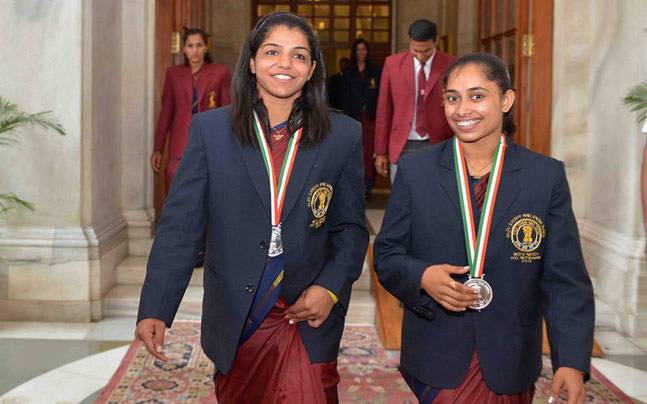This obsession for a prize, which is regarded as the only authenticating evidence of one’s efforts, smacks strongly of the middle-class exhibitionist Indian’s insatiable hunger for accolade, says Aritra Mukherjee.
With Sakshi Malik winning the bronze medal for women’s free-style wrestling and P.V. Sindhu bagging the silver for women’s badminton, India finally arrived at its long-awaited victorious closure in the 2016 Rio Olympics. Quite predictably, the exemplary achievements of Malik and Sindhu, besides the equally commendable efforts of other participants like gymnast Dipa Karmakar and marathon runner O.P. Jaisha, have already been integrated into the discourse of women’s patriotic potentialities. In a bid to instantiate the argument that women are no less than men in matters of representation and protection of national honour, cartoonists like Sandeep Adwaryu and Satish Acharya have chosen to celebrate the glorious achievements and indomitable spirit of these Indian female athletes.
It is true that in an orthodox patriarchal society, where female infanticide, girl trafficking, murder for dowry and various other forms of mental and physical atrocities against women are still a regular occurrence, works like that of Adwaryu and Acharya tend to provide a positive thrust toward the recognition of the worth of a girl child.
If provided with the necessary creative freedom, moral and economic support, and a quality professional training, girls and women are capable of scaling heights as high as those conquered by their male counterparts. Although such a noble thematic concern is geared towards the ultimate realisation of a society where gender equality would make one of the ideal foundational pillars, a closer analysis of one of these cartoons reveals that it is equally rooted in the visual and verbal rhetoric of stereotypes that, wittingly or un-wittingly, reinforce the inequality between the two genders.
In a cartoon by Acharya that marked the event of Raksha Bandhan, we find a smiling, muscular Malik tying her blue ribbon-ed bronze medal on the thin wrist of a masculinised map of India. It is intriguing to note how this seemingly innocent and apparently progressive cartoon deploys the pictorial vocabulary of body politics to suggest a dramatic episode concerning the gendered characters of the sketch. At the very moment when frail-limbed masculine India had been brought down to his knees, despairing of all possibilities of winning any athletic event, Malik arrives with her medal and assures a pleasantly surprised India by saying, “I’LL ALWAYS PROTECT YOUR HONOUR, BHAIYYA.” Too overwhelmed by emotions to say anything, Bhaiyya India is shown to be shedding tears of joy.
Traditionally, the geo-political space of India is imagined and represented in poetry, painting, sculpture and cinema as a maternal figure, whose honour is to be protected by every dutiful and oedipally possessive Indian son worth his salt. Furthermore, during Raksha Bandhan, it is customary that the brother vows to protect the honour of his sister rather than the other way round.
Firstly, Indian women have always been saddled with the task of preserving the masculine honour of their families. The sharp nose on the face of the semi-anthropomorphised map calls to mind one of the commonest proverbial sayings in Hindi, where the figurative cutting off of the nose is construed as a metaphor for public shaming. Anyone having a decent knowledge of the traditional melodramas regularly churned out by Bollywood would be well equipped to recognize, without any shadow of doubt, that the honorably pointed nose, even if it is actually a snubbed one, always finds its place of pride, preferably cushioned by a thick moustache, on the face of the patriarchal head of a family. Therefore, by showing a woman taking responsibility for the maintenance of the honour precariously balanced on the edge of that imposing nose of her Bhaiyya India, Acharya is really not doing anything that can be deemed transgressive by conventional social standards. Secondly, the artist employs the same gender-biased formula, where physical strength, symbolized by heavy musculature, is equated with masculinity and bodily weakness with femininity or effeminacy.Hence, on first seeing Acharya’s cartoon, one feels that this slightly comic inversion of the age-old troupe of Mother India into Brother India is a delightfully expressed challenge to an established patriarchal setup. However, on careful consideration, the work does not seem as unconventionally satirical as it desires to be.
As such, it is never a relationship of mutual support. Rather, it is one where the weaker person, always feminine by birth or by loss of masculine strength, is dependent upon the stronger person, who is masculine by birth or by the shedding of feminine weakness.
Hence, the work fails to escape and go beyond the trappings of an unequal gender discourse.
Moreover, the cartoon has unwittingly fuelled the unsympathetic comments that, overlooking the tremendous amount of hard work put into the preparation for each athletic event, have called into question the competency and dedication of the male athletes, only because they had been unable to win any medals for the country. This obsession for a prize, which is regarded as the only authenticating evidence of one’s efforts, smacks strongly of the middle-class exhibitionist Indian’s insatiable hunger for accolades.
Instead of appreciating the efforts of all the athletes in a non-discriminatory manner, many ill-informed, casual commentators have taken upon themselves to criticize the male participants by overtly stating or covertly implying that, if women could win medals, why couldn’t the men win some for India as well.
Surely, they must have regarded the prestigious sporting event as a holiday, an occasion for clicking and uploading “selfies”. Although Shobhaa De, following her unjustified comment about the performance of the Indian athletes in the Olympics, has received a torrent of sanctimoniously acerbic comment-box rebuttals, some of which crossing all limits of propriety in casting ugly aspersions on her character and even questioning the legitimacy of her children, De’s tweet unknowingly sums up the rash judgment privately vented by many frustrated Indian viewers as they switched off their televisions, and grumbling and sighing made for their beds. In conclusion, one is left wondering: can we ever achieve a gender equal society if we keep using the language and the symbols of inequality? What do we construct by inverting a given paradigm: a shared platform of mutual respect or a new set of hierarchy? If we are actually going out from the front door, are we being careful enough to not find our way back inside through the back door? As I think about these, I look at the cartoon and smile. It is slightly comic for sure, but also serious enough for reasons it probably does not recognize.


